![[SoundStage!]](../sslogo3.gif) Standout Systems Standout SystemsBack Issue Article |
| June 2000 Glowing Tunes à Gogo Prologue You’re hip and you’re happening. You believe in garlic, ginger and onions as natural antibiotics. You swear by ice-cold early-morning showers preceded by piping-hot ones. You adore fresh-squeezed carrot juice with apple and lemon for breakfast thereafter. You believe in exercise, meditation, hard work and passion. You know that heaven is a state of being, not some faraway paradise. You also know that music is food for the soul. Hence, you devour this food wherever you find it -- at dusty roadside stalls, take-out delis or soup kitchens. Sometimes, morsel after delectable morsel, you even sample it with the finesse of a born-again gourmet, during atmospheric candlelight replete with starched linens, high-brow decorator plates and an attendant French-trained maître d’ at your very beck and call. It goes without saying that you’re the proud
owner of a finely tuned audio system for the more private occasions of aural consumption.
But generally, you enjoy your tunes whenever and wherever the mood strikes or the hunger
prompts. Your music collection is bountiful and multiplies according to the Biblical
mandate. Alas, you travel. A lot. And on the road, motel rooms become your temporary abode. Like a nomad, your tent goes up in the most remote and derelict places, with one lone diner in town and nothing to do but hang out in the laundromat or ravish the sheep. How hip are you now?
But, as beauty is in the eye of the beholder and
can change with the blink of a lid, so a hick can make a choice pick and turn seriously
trick. Well, his lowly Compaq Presario 1245 is still with him. No cigar for our magic here, just a bum cigarette butt. Grasshopper must eat more flied lice and practice harder before he’ll turn 300MHz no-name chips into 750MHz wonder Pentium IIIs. But wait, check out that -- that thang, that whatever-it-is -- and dig those strange wooden protuberances. Ha, my secret Adobe Photoshop Deluxe morphing spell did accomplish something after all. Look at the smile on that cat’s face. And those threads. Man, he doesn’t even look like the same fellow. The call With the stage now set, let me dial in the background lighting for you. It’s some months back. Our real-time SoundStage! coverage of the Montreal hi-fi show features our customary standout room reports. Amongst them I spot Tash Goka’s Divergent Technologies-sponsored system. It sports Reference 3A speakers and tube amps by Antique Sound Lab. Valves! The little green antennas on my forehead slide out and turn erectile. Then elsewhere in the show report a picture of a little tube headphone amp by the same company crops up. My Martian barometers of lust now begin to hum and vibrate out of control. Yours truly accedes to their perspicacity and logs onto Goka’s website pronto. Clicking onto the Antique Sound Lab header, I’m dumbfounded to find a veritable plethora of Chinese-made tube gear with pricing that looks like a downright mistake. Before the Asia connection turns you yellow with stomach cramps -- no dog meat here -- let me assure you that many audio-dealer friends of mine carry the Chinese Jolida marquee. Their feedback has long since convinced me that Chinese-made tube amplifiers don’t automatically equate unreliable or badly put together. Except for uncommon affordability, there’s nothing wrong with these pieces not to be called certifiable high-performance audio. To believe otherwise is just another form of audio fascism. Unfortunately it’s widespread and rather fashionable, so let’s call it audio fashism. To remain untouched by its ill-informed, judgmental and contagious lure, I quickly field a call to dealer acquaintance Albert at Holm Audio in Chicago. Al’s immediately gushing about the $1400 USD Antique Sound Lab KI15Fox AQ1001 15Wpc single-ended integrated amplifier. It sports the Russian 6C33s that BAT first brought to prominence with their VK-60. Albert proclaims the Chinese amplifier built like a tank, with sonics far in excess of its price. He simply calls it an absolute no-brainer in terms of performance-for-the-dollar and reports that his demo sold in a matter of hours. The bloke’s been around the block for going on two decades and is the only US dealer to carry the much-praised PipeDream speakers. He’s seen and heard it all and doesn’t just fly off his handle for nothing. Add to his endorsement the fact that I’d met
Tash Goka at numerous trade shows. I was always thoroughly impressed with his obvious
passion for music. His professionalism, conduct and repute as an audio importer are
immaculate. Knowing my fondness for Middle-Eastern music, he once even gifted me with some
Mediterranean CDs he purchased during a trip back home to Turkey. If Goka, who also
distributes the excellent Primare and Copland brands, is the man behind Antique Sound Lab,
I feel reassured. He wouldn’t touch something that didn’t deserve it. My only
remaining legitimate concern is tube noise. Headphones require a much lower noise floor
than speakers. At $250 USD retail, I’m worried that the little ASL MGHead, no matter
how seductive-sounding, wouldn’t quite cut the mustard in the peace-and-quiet
department. An e-mail to Goka hips me about an available upgrade that he installs for an
additional $100. He replaces the two main internal caps with Multicaps, the volume pot
with an Alps potentiometer and the stock tubes with JJs. I had told him that I wanted to
use my high-end Grado RS-1 headphones. He feels this mod significantly improves the
unit and would make it a perfect match for my favored cans. While the Grado’s
impedance isn’t suitable for the average portable audio rig, the MGHead’s
output-transformer windings are split into high- and low-impedance taps. You select the
appropriate setting via a toggle switch on the front panel. I command my green tentacles
at ease, wipe the gooey slime off my forehead and write a check. At $350 USD total, not to
upgrade would have been the entirely un-hip thing to do. About that sound. I love to do some of my SoundStage! music reviews when I’m on the road and stuck in boring motel rooms. The little $40 USD Sony MDR-G52s I purchased during my last trip at a local Whiz work OK. There’s sound coming out at the end, but it’s like the rusty water trickle out of a funky wayward motel -- no water pressure. There’s no drive in the music, no dimension, just cardboard flatness. This is painfully obvious when I play the same CDs not only over my regular system but even on the stock car stereo of my Windstar van. The fault may be less the Sony’s and more the op-amp’s in the computer, but bad is bad no matter whose fault. The MGHead/Grado combo promised to change all that. The only item still missing is le plug. I need a 3.5mm headphone-jack-to-dual-RCA umbilical adapter cable for instant plug ’n’ play connectivity. I’m not quite desperate enough yet to attack my local Radio Shack. I will only use the trusty one-stop haven as last resort. I have a better idea to try first. Readers of my
regular column know about the Analysis Plus cables. I stumbled upon them in
December of last year. I’ve been wired with hollow oval cables ever since -- much
better than caffeine. Longer lasting, too. I have irrevocably converted. For the money, I
haven’t heard better cables yet, period. I’ve owned my wooden Grados for a long time now. I whispered into my wife’s ears once and she subsequently bought them for me as a birthday present. Appropriately -- considering what they’re made out of -- I’m still getting a woody each time I use them. There are only two headphones I’ve personally heard that seem significantly better to these ears to warrant mention. The 74dB inefficient but groundbreaking AKG 1000s are phenomenal and really do take the image out of the head with their ingenious wing arrangement. However, they require a very muscular high-gain head amp or better yet, should be hard-wired to your resident amp’s speaker outputs. My former McCormack Micro in 10Wpc hi-gain setting was barely up to the task. The triode-driven new SR-404 Signature Stax electrostatic ear speakers are miniature Sound Lab or Final stats and airy as whipped cream. With their matching SRM-006t driver amp, they retail for a fair but significant $2365 USD. Both the AKGs and Staxes are a little rich for my commoner’s blood. I’m sticking with my beloved Grados sans regrets. Grado’s less-expensive RS-2s use the same open-backed, cured mahogany body and are said to offer more than 85% of their costlier sibling’s performance. They should be on your list if you’re thinking about high-quality headphones. Ditto for the similarly priced Sennheiser 600s. The band Plenty’s been written about the Grados, so excuse me from reiterating it all. Suffice to say that they’re fabulously musical, slightly fat but very extended in the bass, ultra-smooth in the top, gloriously warm in the midrange and plainly very pleasurable to listen to. Recording engineers might rightly favor the Sennheisers for their greater neutrality and objectivity, but for sheer aural sex, my vote goes to the Grados. If the German Sennheisers are violins, the Yankee Grados are cellos -- fuller, richer and warmer. The RS-1s are also very light and supremely comfortable, which can’t be said for all Grados. What can I mention about the Compaq except that
its apparently flimsy CD/ROM drive flies in the face of gargantuan, double-suspended,
mechanically damped transport mechanisms on gold-anodized spikes and with all-separate
power supplies? We’re not talking high-falutin’ high end here but raw
convenience. This thing spins CDs, doesn’t skip, and the on-screen mini screen allows
for track selection, programming, repeat play and elapsed time displays. You can write
reports, love letters or reviews while you listen. You want to know what more a duffer in a motel room could ask for? Losing his wallet next, now that the hearing’s gone? If that happened, you’d be left with this
little triode amp. Perhaps you could trade it in for a free night of room and board if the
motel proprietor didn’t need a dishwasher and if he knew what he was looking
at. Chances are, he’ll be flabbergasted at the sight of it. So keep the volume at
reasonable levels, pay your bills the old-fashioned green way, hold on to the amp and find
out with me how it sounds. It’s certainly not built like any other piece of $250
audio gear I’ve ever seen. I’ve owned the McCormack Micro that began life as a
dedicated headphone amp. The designer realized afterwards how good of a regular preamp it
was. He added inputs and outputs and even speaker terminals for high-efficiency speakers.
He re-christened the unit the Micro Integrated and its price went from $595 to $795. The
MGHead doesn’t suffer the comparison at all by mere visual inspection. It certainly
wins out in the weight contest, compliments of its transformers. The intestines don’t
seem due for a colonic anytime soon, as the photo shows. External and internal fit
’n’ finish, while not in the glitz department, is more than respectable and
surprising for the money. The audience To establish what this little head amp could do, I connect it first to my regular front-end, a Marantz CDR 630 semi-professional CD recorder via a pair of Analysis Plus Oval-Ins. The next step down would be to connect it to the Compaq via the Analysis Plus pigtail. The last step, ground zero, will substitute the pigtail for a Radio Shack, Taiwan-manufactured zip cord. Let’s talk noise floor since I was initially worried about it. In the stationary configuration, hooked up to my Marantz, the MGHead is deadly quiet all the way to its 1/7th Wpc full power output. There’s no hum or hiss of any kind even with the attenuator wide open. Ditto for the trannies -- no grunge, no buzz, just grave-like peace. One major thumbs-up for the engineers. With the Compaq, noise does creep in from upwards of the 10:30 volume setting. Past high noon, this noise is wearing spurs and smoking guns and ready to rumble. Good thing I checked the Head on the Marantz first. I know without a doubt that the substandard quality of the laptop’s analog output plus probably tons of digital switching noise from the ICs are the culprit. The tubes are innocent. Fortunately, the same setting at which noise without a signal first becomes audible over the Compaq proves to be the maximum output my ears are capable of before clipping. Unless you’re half deaf, all listening will take place well below any audible background noise. Sonics in direct hook up to a decent source are truly excellent. The sound is full-bodied, rich and muscular but avoids bloat and drag. It’s typical triode seduction without the common roll-off in the frequency extremes because the tubes are barely coasting. In fact, the sense of robustness and meatiness is nearly pentode. It’s not the lushness and wetness one expects from micro-power triodes -- it’s too big for that. I’d call it fat only if you promise to understand that it’s not slow or thick, merely very saturated and gorgeous, the perfect antidote for tinnitus. Maybe it’s not as airy as the Stax head amp, but you can’t listen to it with the Grados. It’s definitely not as dry as Grado’s own amp or the McCormack. Preferences will vary, but if you like your women buxom and shapely, your dogs large and your plate full, the Antique Sound Lab fits your bill like nothing else I’ve heard under $1000. Of course, with headphones you don’t get the sound-staging magic of which tubes generally prove very capable. You also don’t have to worry about replacing tubes as you might if you drive speakers. Unless you get a lemon valve, which usually shows up within the first three months of use, small signal tubes last for more years than you have time to listen. À gogo, the Compaq’s limitations create a significant veil. It’s like cotton candy. It obscures immediacy and literally downgrades your front-center seats to row 25 or further. It’s as though the sound has to travel through something first before it is free to caress your cochlea. However, in comparison to just plugging straight into the Compaq with the ‘lil Sonys, there is no comparison. Tin city goodbye. Throw the aluminum cans out the window and begin drinking your suds from real glass. The music’s all here now, without any low-fi aberrations, hardness or honkiness. What’s missing is merely the eye-to-eye contact with the muse, the difference between being "here" and being "present." Whether a portable CD player or more sophisticated laptop would improve its source-worthiness over my entry-level Compaq I don’t know. It’s certainly something to investigate. The encore If Antique Sound Lab and the outrageously fair --
no, make that stupid and thank the Communists for it -- pricing of distributor Divergent
Technologies can give so much with so little in the MGHead triode headphone amplifier,
what other cherries hide in the remainder of this tubular lineup? I have it on good
authority that SoundStage! has arranged for future reviews of ASL gear in these
cyber pages soon. Stay tuned. In the meantime, do yourself a favor. Whether hooked up to a
laptop, the tape loop of your preamplifier or a second analog out on your Arcam or Linn CD
player -- if you’re at all into the intimate seclusion that is the headphone
experience but ...Srajan Ebaen
|
|
![[SoundStage!]](../sslogo3.gif) All Contents All ContentsCopyright © 2000 SoundStage! All Rights Reserved |
 Your sweet spot is wide enough to embrace at least three. You
can’t remember the last time when you read a review on a piece of audio gear. You
know what you like. You don’t care a hoot whether anybody else agrees with it or not.
You especially don’t care for people’s opinions whose hearing you
can’t vouch for because you’ve never personally observed it in action.
Your sweet spot is wide enough to embrace at least three. You
can’t remember the last time when you read a review on a piece of audio gear. You
know what you like. You don’t care a hoot whether anybody else agrees with it or not.
You especially don’t care for people’s opinions whose hearing you
can’t vouch for because you’ve never personally observed it in action. Well, if you brought your
laptop and remembered the AC adapter, there’s hope. Your surrogate silicon
brain’s got to be outfitted with a CD/ROM drive but you watched for that when you
bought it. Which means you also know what that little mini jack with the handcuff icon is
for -- headphones. Unless you grew up in tin-city and love posing for photographs with
two-dimensional cutout politicians and dead movie stars, you even know something else.
Little good comes from just plugging straight into the hole and expecting any semblance of
magic. For potent proof, look at Sir John from the Redwood Forest over yonder. His
low-rider Sony cans, baseball cap and shades indicate that he thinks sipping suds through
a straw is mightily hip and happening. If you were his ears, though, you’d listen
beyond this charade and know him to be a hick.
Well, if you brought your
laptop and remembered the AC adapter, there’s hope. Your surrogate silicon
brain’s got to be outfitted with a CD/ROM drive but you watched for that when you
bought it. Which means you also know what that little mini jack with the handcuff icon is
for -- headphones. Unless you grew up in tin-city and love posing for photographs with
two-dimensional cutout politicians and dead movie stars, you even know something else.
Little good comes from just plugging straight into the hole and expecting any semblance of
magic. For potent proof, look at Sir John from the Redwood Forest over yonder. His
low-rider Sony cans, baseball cap and shades indicate that he thinks sipping suds through
a straw is mightily hip and happening. If you were his ears, though, you’d listen
beyond this charade and know him to be a hick. 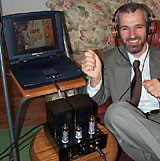 Abracadabra, smoke and white gloves. Let’s transform
our yokel into columnist Srajan the SoundStager and take a closer look at his
scene.
Abracadabra, smoke and white gloves. Let’s transform
our yokel into columnist Srajan the SoundStager and take a closer look at his
scene. 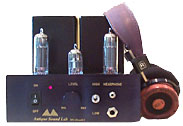 Here you finally
get to have your cake and eat it too. Become a custom guy with special-order mods. I order
the Tash-modified little thermionic head amp sight unseen and on the spot. I cleverly
figure that the tubes on the chassis are spaced closely enough together to allow for the
sandwiching of two slices of bread in between. I could always use the MGHead as a foppish
travel toaster if, against all odds of the tube gods, I don’t dig the sound.
Here you finally
get to have your cake and eat it too. Become a custom guy with special-order mods. I order
the Tash-modified little thermionic head amp sight unseen and on the spot. I cleverly
figure that the tubes on the chassis are spaced closely enough together to allow for the
sandwiching of two slices of bread in between. I could always use the MGHead as a foppish
travel toaster if, against all odds of the tube gods, I don’t dig the sound. 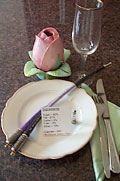 I now inquire
whether they could make up a short pair of their regular Oval-In interconnect but
terminate them in "Y" style with a 1/4" plug on one end. I’d get a
converter to downsize to the mini plug the laptop requires. Making this beast must have
elicited a few unpronounceable curses at Analysis Plus. There’s precious little room
on a professional stereo plug to solder two shielded leads to it. I know that going
straight to the mini plug is asking for the impossible. Flimsy 20 AWG zip cord will work,
but more substantial stuff just doesn’t fit. The Analysis Plus team proves undeterred
and delivers the 1/4" pigtails for my Compaq in short order. With many thanks to
principals Mark Markel and Steve Pennock, I’m ready to pig out and have a five-course
concert.
I now inquire
whether they could make up a short pair of their regular Oval-In interconnect but
terminate them in "Y" style with a 1/4" plug on one end. I’d get a
converter to downsize to the mini plug the laptop requires. Making this beast must have
elicited a few unpronounceable curses at Analysis Plus. There’s precious little room
on a professional stereo plug to solder two shielded leads to it. I know that going
straight to the mini plug is asking for the impossible. Flimsy 20 AWG zip cord will work,
but more substantial stuff just doesn’t fit. The Analysis Plus team proves undeterred
and delivers the 1/4" pigtails for my Compaq in short order. With many thanks to
principals Mark Markel and Steve Pennock, I’m ready to pig out and have a five-course
concert. 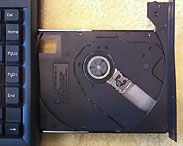 Do all of this at
2:00 o’clock in the morning and you won’t disturb a soul or occupy more than
four square feet. Better still, you can pack it all up afterwards and repeat the whole
experience wherever there’s an AC receptacle. Plus, you get to play at any decibels
you want without taking votes. It must be said here in warning and at deafeningly loud and
clear levels that extended listening at high volumes, especially over headphones, can
cause permanent and irreparable hearing damage.
Do all of this at
2:00 o’clock in the morning and you won’t disturb a soul or occupy more than
four square feet. Better still, you can pack it all up afterwards and repeat the whole
experience wherever there’s an AC receptacle. Plus, you get to play at any decibels
you want without taking votes. It must be said here in warning and at deafeningly loud and
clear levels that extended listening at high volumes, especially over headphones, can
cause permanent and irreparable hearing damage.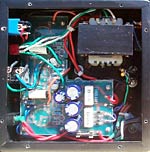 The MG-HeadDT is clean, chunky and black,
with high-quality RCAs and one bonus 3.5mm input aft next to the properly grounded
three-prong captive power cord. Up front there are both 3.5mm and 1/4" headphone
inputs, the hi-low impedance switch, the power switch and a red pilot light. The headphone
jacks cannot be used together -- the 1/4" input overrides and mutes the mini jack.
The driver tube is a single 12AX7 dual triode and output tubes are one 6BQ5/EL84 per
channel. The tube cover removes easily by loosening two Phillips screws. The power and
output transformers must be potted because a knuckle rap upon their covers elicits only a
dead bonk. And that’s it.
The MG-HeadDT is clean, chunky and black,
with high-quality RCAs and one bonus 3.5mm input aft next to the properly grounded
three-prong captive power cord. Up front there are both 3.5mm and 1/4" headphone
inputs, the hi-low impedance switch, the power switch and a red pilot light. The headphone
jacks cannot be used together -- the 1/4" input overrides and mutes the mini jack.
The driver tube is a single 12AX7 dual triode and output tubes are one 6BQ5/EL84 per
channel. The tube cover removes easily by loosening two Phillips screws. The power and
output transformers must be potted because a knuckle rap upon their covers elicits only a
dead bonk. And that’s it. don’t have a headphone socket; if you
wisely poo-poo the op-amp headphone socket you do have; if you want to hear the magic of
tubes on the cheap; if you want travel-ready high-end musicality -- check out the combo
that is the hot-rodded MGHead and Grado RS-1s à gogo. They go together like hand in
glove. It’s a slice of the higher musical heavens. In my book, it’s also a
rather fat slice at that.
don’t have a headphone socket; if you
wisely poo-poo the op-amp headphone socket you do have; if you want to hear the magic of
tubes on the cheap; if you want travel-ready high-end musicality -- check out the combo
that is the hot-rodded MGHead and Grado RS-1s à gogo. They go together like hand in
glove. It’s a slice of the higher musical heavens. In my book, it’s also a
rather fat slice at that.